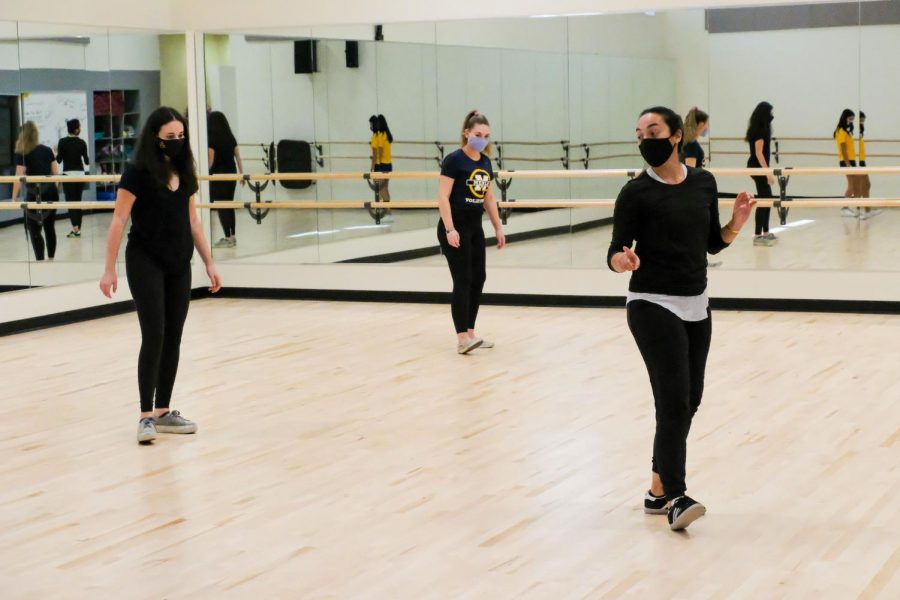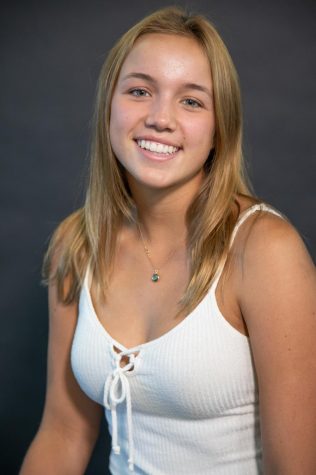Teachers’ Plans Vary for Second Hybrid Learning Session
Dance teacherAngela Curotto-Pierson teaches choreography to in-person and online students during Menlo’s trial hybrid learning model. Photo courtesy of Pete Zivkov.
January 18, 2021
After four weeks of hybrid learning prior to Thanksgiving, Menlo teachers reflected on what needs to be modified and on what teaching strategies will work best for Menlo’s return to hybrid learning on Jan. 19. As it was a foreign experience, some teachers had difficulty adjusting to classes that included students both in the classroom and on Zoom. Specifically, many teachers described that the main difficulty with hybrid learning is ensuring that all students are included in class activities.
Math teacher Leanne Rouser was able to make adjustments over the four-week hybrid period last fall to guarantee that her class remained connected. “In the first week of hybrid I was so excited to see the in-person people that I kind of forgot for a moment about the people on the screen, but as the weeks progressed, I got better at balancing it,” Rouser said.
For Rouser, the adjustment from in-person to virtual learning was not very difficult because she has always used the Smartboard, a digital whiteboard, in her classroom. The only difference is that she now has to screen share the Smartboard with her students on Zoom.
In addition, Rouser wants to take advantage of having students in person. Therefore, while she plans to continue to use breakout rooms for students on Zoom during hybrid learning, she plans to mimic breakout rooms in the classroom with students working together in groups while the virtual breakout rooms are active.
Science teacher James Dann teaches multiple project-based classes in the Whitaker Lab. His students pick up materials to perform those projects at home. Dann’s plan for the second hybrid learning session is similar to the first session. “I plan to have parts when we’re all together when it is an important topic. And then, since it’s every other week, [during] the second half of class, I’ll focus a little more on the in-person people if we are doing a project and maybe have the online students get a jump start on writing the paper or doing other things that are more amenable to being online,” Dann said.
Other classes, such as those in creative arts, consist of more hands-on or aerobic activities. Dance teacher Angela Curotto-Pierson has faced multiple challenges with creating class plans that are socially distanced and allow the students to partake in normal dance exercises. On average, there are 10 students in each dance class, but the number of students on campus varied weekly. “Every week, I taught class, either outside or in my room, or maybe only one person came so it was never the same. So I guess the challenge was kind of just rolling with the punches,” Curotto-Pierson said. Curotto-Pierson acknowledges that her students on Zoom may feel somewhat disconnected from the in-person group, so she is trying to create an environment where everyone feels like they are working together.
Studio art teacher Nina Ollikainen had a somewhat different experience teaching students who were at school during hybrid learning last fall because she opted to continue teaching from home, citing health reasons. To prepare the art room for the first session of hybrid learning, Ollikainen worked in the room on the weekends to organize and prepare supplies for the students and has a webcam for creating both live and recorded art demonstrations.
During classes, another teacher would be present in the art room to supervise and help students. “My greatest difficulty with the hybrid model is not having art facilitators in the classroom. The monitors of the first hybrid were wonderful, yet most were not accustomed to art materials and processes which hindered their ability to help students,” Ollikainen said. Nonetheless, Ollikainen and her students were able to work around the challenges by sharing their work through the screen, allowing Ollikainen to give feedback and advice on the pieces.



